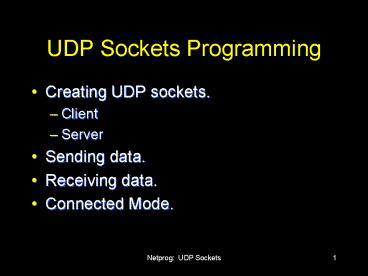UDP Sockets Programming PowerPoint PPT Presentation
1 / 19
Title: UDP Sockets Programming
1
UDP Sockets Programming
- Creating UDP sockets.
- Client
- Server
- Sending data.
- Receiving data.
- Connected Mode.
2
Creating a UDP socket
- int socket(int family,int type,int proto)
- int sock
- sock socket( PF_INET, SOCK_DGRAM,
- 0)
- if (socklt0) / ERROR /
3
Binding to well known address(typically done by
server only)
- int mysock
- struct sockaddr_in myaddr
- mysock socket(PF_INET,SOCK_DGRAM,0)
- myaddr.sin_family AF_INET
- myaddr.sin_port htons( 1234 )
- myaddr.sin_addr htonl( INADDR_ANY )
- bind(mysock, myaddr, sizeof(myaddr))
4
Sending UDP Datagrams
- ssize_t sendto( int sockfd,
- void buff,
- size_t nbytes,
- int flags,
- const struct sockaddr to,
- socklen_t addrlen)
- sockfd is a UDP socket
- buff is the address of the data (nbytes long)
- to is the address of a sockaddr containing the
destination address. - Return value is the number of bytes sent, or -1
on error.
5
sendto()
- You can send 0 bytes of data!
- Some possible errors
- EBADF, ENOTSOCK bad socket descriptor
- EFAULT bad buffer address
- EMSGSIZE message too large
- ENOBUFS system buffers are full
6
More sendto()
- The return value of sendto() indicates how much
data was accepted by the O.S. for sending as a
datagram - not how much data made it to the
destination. - There is no error condition that indicates that
the destination did not get the data!!!
7
Receiving UDP Datagrams
- ssize_t recvfrom( int sockfd,
- void buff,
- size_t nbytes,
- int flags,
- struct sockaddr from,
- socklen_t fromaddrlen)
- sockfd is a UDP socket
- buff is the address of a buffer (nbytes long)
- from is the address of a sockaddr.
- Return value is the number of bytes received and
put into buff, or -1 on error.
8
recvfrom()
- If buff is not large enough, any extra data is
lost forever... - You can receive 0 bytes of data!
- The sockaddr at from is filled in with the
address of the sender. - You should set fromaddrlen before calling.
- If from and fromaddrlen are NULL we dont find
out who sent the data.
9
More recvfrom()
- Same errors as sendto, but also
- EINTR System call interrupted by signal.
- Unless you do something special - recvfrom
doesnt return until there is a datagram
available.
10
Typical UDP client code
- Create UDP socket.
- Create sockaddr with address of server.
- Call sendto(), sending request to the server. No
call to bind() is necessary! - Possibly call recvfrom() (if we need a reply).
11
Typical UDP Server code
- Create UDP socket and bind to well known address.
- Call recvfrom() to get a request, noting the
address of the client. - Process request and send reply back with sendto().
12
UDP Echo Server
- int mysock
- struct sockaddr_in myaddr, cliaddr
- char msgbufMAXLEN
- socklen_t clilen
- int msglen
- mysock socket(PF_INET,SOCK_DGRAM,0)
- myaddr.sin_family AF_INET
- myaddr.sin_port htons( S_PORT )
- myaddr.sin_addr htonl( INADDR_ANY )
- bind(mysock, myaddr, sizeof(myaddr))
- while (1)
- lensizeof(cliaddr)
- msglenrecvfrom(mysock,msgbuf,MAXLEN,0,cliaddr,
clilen) - sendto(mysock,msgbuf,msglen,0,cliaddr,clilen)
NEED TO CHECK FOR ERRORS!!!
13
Debugging
- Debugging UDP can be difficult.
- Write routines to print out sockaddrs.
- Use trace, strace, ptrace, truss, etc.
- Include code that can handle unexpected
situations.
14
Timeout when calling recvfrom()
- It might be nice to have each call to recvfrom()
return after a specified period of time even if
there is no incoming datagram. - We can do this by using SIGALRM and wrapping each
call to recvfrom() with a call to alarm()
15
recvfrom()and alarm()
- signal(SIGALRM, sig_alrm)
- alarm(max_time_to_wait)
- if (recvfrom()lt0)
- if (errnoEINTR)
- / timed out /
- else
- / some other error /
- else
- / no error or time out
- - turn off alarm /
- alarm(0)
There are some other (better) ways to do this -
check out section 13.2
16
Connected mode
- A UDP socket can be used in a call to connect().
- This simply tells the O.S. the address of the
peer. - No handshake is made to establish that the peer
exists. - No data of any kind is sent on the network as a
result of calling connect() on a UDP socket.
17
Connected UDP
- Once a UDP socket is connected
- can use sendto() with a null dest. address
- can use write() and send()
- can use read() and recv()
- only datagrams from the peer will be returned.
- Asynchronous errors will be returned to the
process.
OS Specific, some wont do this!
18
Asynchronous Errors
- What happens if a client sends data to a server
that is not running? - ICMP port unreachable error is generated by
receiving host and sent to sending host. - The ICMP error may reach the sending host after
sendto() has already returned! - The next call dealing with the socket could
return the error.
19
Back to UDP connect()
- Connect() is typically used with UDP when
communication is with a single peer only. - Many UDP clients use connect().
- Some servers (TFTP).
- It is possible to disconnect and connect the same
socket to a new peer.

